Factors that must be taken into consideration when installing consumer units outside
Objective: This article considers the factors that must be taken into consideration when installing equipment such as consumer units on the outside of a premises to facilitate the connection of alternative sources of supply and the charging of electric vehicles to an existing electrical installation. It will also consider the various ways in which such an addition to an electrical installation may be carried out in order to conform to the relevant requirements of BS 7671.
Introduction
Additions to an existing electrical installation such as when installing electric vehicle charging points, heat pumps and battery storage systems can be achieved in different ways. These include the following, although not all options may be appropriate at every property:
Use of existing consumer’s distribution equipment
In some cases, there may be sufficient spare capacity and continued availability of compatible equipment such as RCCBs, RCBOs, circuit-breakers and the like to connect the new equipment to an existing consumer unit within the premises. Where this option is to be employed it must be determined that any devices or components to be incorporated into the existing consumer unit are suitable for such use by the consumer unit’s manufacturer (536.4.203). See Fig 1.
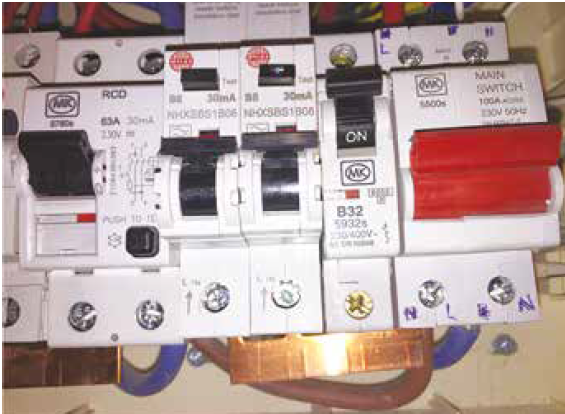
Provision of an additional consumer unit at or near the existing consumer’s distribution equipment
In other cases, there may be sufficient space available, in a suitably accessible location, to install an additional smaller consumer unit near the existing intake equipment and first piece of consumer’s distribution equipment. As is the case with using the existing consumer unit, this option has the benefit of placing all switchgear that may need to be operated by the consumer in the same accessible location. See Fig 2.
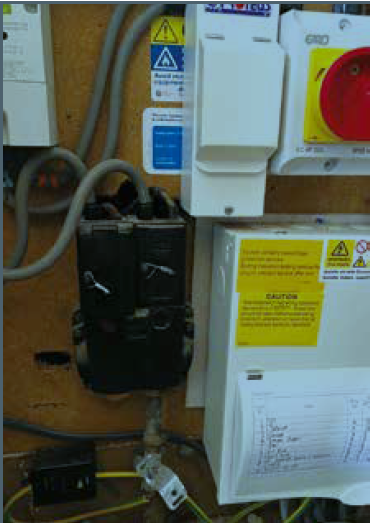
Provision of an additional consumer unit on the exterior of the property
On occasion however, neither of the previous options may be a practical proposition and this, coupled with the physical location of the equipment to be installed in relation to that of the existing first piece of consumer’s distribution equipment, may lead to the installation of a consumer unit on the exterior of a domestic premises. This option will be considered in greater detail in the remainder of this article.
Do not install consumer’s electrical equipment in the external meter box!
A meter enclosure must be provided at the service position of a premises to allow for the installation of the intake and metering equipment. The space allocation within this enclosure allows for the replacement of equipment at the end of its service life, installation of smart metering equipment and for some degree of future supply capacity upgrade.
Only intake and metering equipment should be installed in the meter enclosure. No allowance of space has been made for housing additional equipment not associated with those functions.
If a Distribution Network Operator (DNO) or Meter Operator (MOP) attends the premises to carry out work on their equipment and insufficient space is provided within the meter enclosure, work will not be able to proceed. The customer will need to organise (at their expense) the removal of unapproved equipment to create the space needed for the work to be carried out.
NICEIC strongly recommends that registered contractors do not install any other equipment within meter enclosures. See Fig 3.
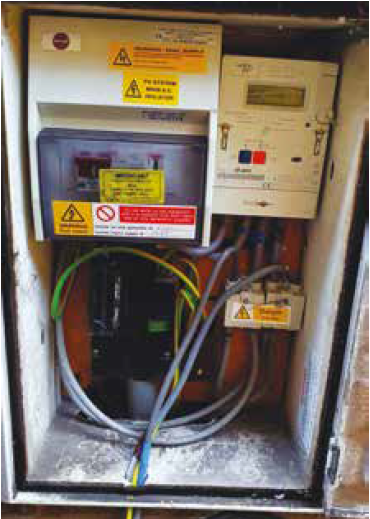
The installation of equipment in meter boxes was covered in greater depth in an article published in Issue 220 (Winter 2021-22) of Connections.
BS 7671 requirements where consumer units are installed outdoors
Suitability for the environment either intrinsically or extrinsically by provision of supplementary protection
As is the case for any electrical installation work, equipment must either be of a design appropriate to the situation in which it is to be used, or it should be installed in a manner appropriate to any conditions likely to be encountered (512.2.1). Where equipment is not intrinsically suitable for the external influences to which it will be exposed once installed, it may still be used, however, if it is provided with the necessary degree of protection by other methods. In such cases, any such supplementary protection must not have an adverse effect on the operation of the equipment being protected (512.2.2).
Where a consumer unit is not deemed to be suitable for use externally its installation in such a location might be acceptable if it was installed within a separate enclosure providing the required degree of protection in respect of, for example, ingress by water or solid foreign particles. However, it would be necessary to confirm that so doing would not have a detrimental effect on the operation of protective devices housed within the consumer unit as it is necessary to ensure proper functioning and reliability of the measures being relied on for protection of the installation (512.2.4).
Alternatively, the consumer unit could be placed in a location outside the dwelling, but not directly exposed to the weather, such as inside a garage or outbuilding or under a porch or car port.
PD IEC TR 61439-0:2022 Low-voltage switchgear and controlgear assemblies. Part 0: Guidance to specifying assemblies is a technical report providing explanations of characteristics of assemblies such as consumer units, guidance on defining desired characteristics and selecting appropriate options to meet the needs of a particular application, and assistance to those specifying such assemblies. Where mention is made to ‘clauses’ hereafter in this article these are references to clauses within this technical report.
Further PD IEC TR 61439-0 states that an assembly may be specified as being suitable for indoor or outdoor locations. Any references to the technical report in this article will only relate to suitability for outdoor locations.
External influences
The following external influences will need to be taken into consideration when installing a consumer unit externally:
• Ambient temperature (AA)
• Presence of water (AD) or high humidity (AB)
• Presence of solid foreign bodies (AE)
• Presence of corrosive substances (AF)
• Impact (AG)
• Presence of flora and/or mould growth (AK) – not discussed in this article
• Presence of fauna (AL)
• Solar radiation (AN) and ultra-violet radiation
Ambient temperature
Electrical equipment, including consumer units, must be suitable for the highest and lowest temperatures to be expected at their point of installation (522.1). For outdoor locations, assemblies conforming to the BS EN 61439 series will be designed for use in ambient temperatures of between -25 °C and +40 °C (Clause 8.7).
Presence of water (AD) or high humidity
In general, in respect of presence of water, assemblies are considered suitable for outdoor use where they provide a degree of protection of at least IPX3 (Clause 8.3). Within BS 7671, this can be seen in the requirements for external influences for outdoor lighting installations (714.512.2.105). Notably a higher degree of protection of IPX4 is required for PV power supply systems (712.512.102) and EV charging installations (722.512.2.201). It is a general requirement that means must be provided, such as drainage holes at the lowest points of enclosures, wherever water may collect, or condensation may form (522.3.2). See Fig 4.
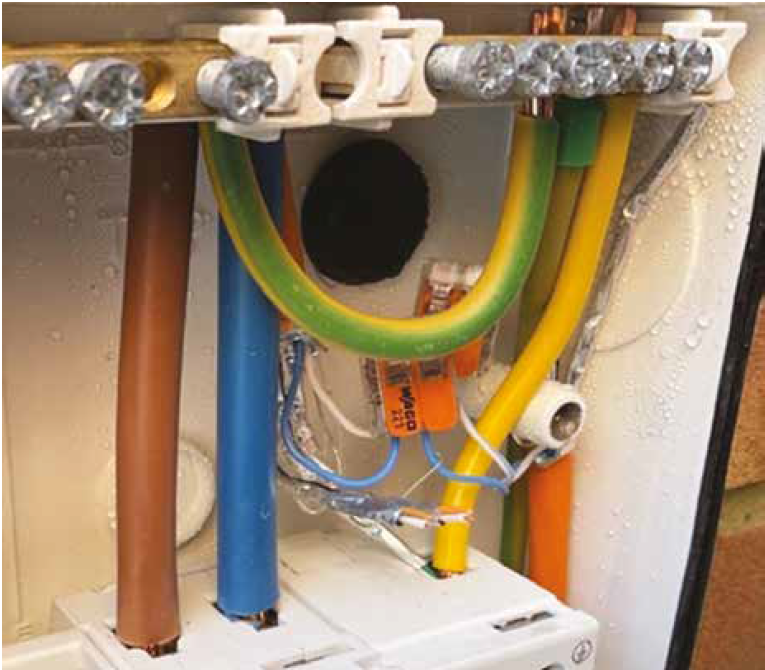
Simple measures such as only terminating cables or wiring systems such as conduits on the underside of the enclosure or via the back of the unit will minimise the likelihood of water ingress.
Assemblies conforming to the BS EN 61439 series are suitable for operation in conditions of 100 % humidity at between -25 °C and +27 °C (Clause 8.8).
Presence of solid foreign bodies (AE)
Where equipment is to be installed outdoors it should provide a degree of protection of at least IP3X (714.512.2.105 & Clause 4.1). As was the case for protection against ingress of water, BS 7671 requires a higher degree of protection of IP4X for PV power supply systems (712.512.102) and EV charging installations (722.512.2.202).
In the case of both resistance to ingress by water/humidity and solid foreign bodies, it is essential that the required degree of ingress protection is maintained after installation (522.6.4).
Presence of corrosive substances (AF)
Noting that water is considered to be a polluting substance, equipment constructed fully or partly of metal installed outdoors will be susceptible to corrosion. The likelihood of corrosion taking place will be increased at points where the protective coating has been damaged and not been recoated afterwards; especially so where the atmosphere is salt-laden as would be expected to be the case for installations close to the coast (522.5.1). Ferrous metallic assemblies conforming to the BS EN 61439 series intended for outdoor use are required to be resistant to such conditions (Clause 8.6).
Impact (AG)
For a consumer unit for outdoor use,
BS EN 61439-3:20121 requires a minimum degree of protection against mechanical impact of IK07 (Clause 8.2.1). This minimum degree of protection is also required for solar PV systems (712.512.102). However, those parts of an EV charging installation installed outdoors are required to be protected against impacts of high severity (AG3), with a minimum degree of protection against impact of IK08 (722.512.2.203).
BS 7671 specifies that, in a fixed installation where impacts of medium severity (AG2) or high severity (AG3) can occur, protection shall be provided by:
(i) the mechanical characteristics of the wiring system, or
(ii) the location selected, or
(iii) the provision of additional local or general protection against mechanical damage, or
(iv) any combination of the above (522.6.2).
Moreover, the degree of protection provided must be maintained on completion of the installation process (522.6.4). See Fig 5.
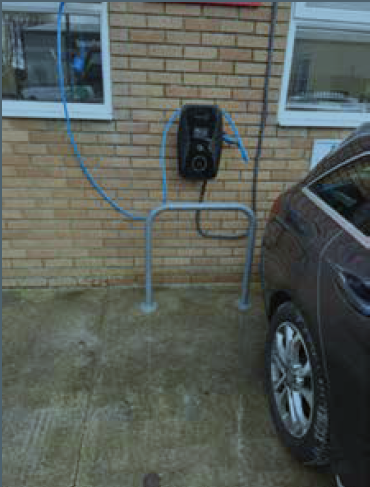
Presence of fauna (AL)
It is important that any required degree of ingress protection (IP rating) of equipment is maintained not only to prevent penetration by water and solid objects but also by animals of various sizes. It is an all-too-common occurrence to find that animals ranging in size from small insects and spiders to rodents such as mice (see Fig 6) have made their way into electrical enclosures and caused damage or operation of protective devices. While maintaining the integrity of an enclosure to prevent entry of the larger rodents is readily achievable, keeping insects, spiders and the like out is more problematic, particularly when providing drainage holes to allow for the escape of water or condensate. As a rule, any entries should be kept as small as is practicably possible.

Solar radiation (AN) and ultra-violet (UV) radiation
Equipment installed outdoors will be exposed to some degree of exposure to direct sunlight (solar irradiance) and UV radiation. Where the degree of exposure is sufficient to cause damage or premature failure, such equipment so located should be either intrinsically suitable for such exposure or it should be provided with additional protection sufficient to protect it from damage (522.11). Enclosures declared suitable for outdoor use conforming to the BS EN 61439 series intended to be exposed to direct sunlight will be manufactured in a manner which makes them suitable for such use (Clause 8.5.3).
Manufacturers’ instructions
Whenever selecting equipment for use in an electrical installation account should be taken of manufacturers’ instructions (510.3). Even where a consumer unit meets or exceeds the minimum requirements for use outdoors in respect of the factors discussed previously in this article, a manufacturer may well still state in the product information that the equipment is only suitable for indoor use.
Beware of over-specification!
PD IEC TR 61439-0 warns against over-specifying an assembly:
Specifiers are cautioned against over-specifying their requirements; it may not lead to a more appropriate assembly for their application. More onerous requirements for one criterion usually have a negative impact on others. For example, an outdoor assembly being specified to comply with IP66 of IEC 60529, when a lower IP degree, for example IP33, will suffice, can:
• increase temperatures within the assembly due to the lack of ventilation with the effect that the insulation ages more quickly;
• increase the risk of condensation causing tracking due to there being no ventilation and therefore no air exchange with the environment outside of the assembly; and
• make the assembly larger and more expensive due to the need to manage the lack of ventilation.
IEC TR 61439-0:2022. Clause 4.1
This warning is equally applicable to the selection of such products.
Summary
Increasingly, consumer units are being installed outdoors to supply equipment such as electric vehicle charging points, heat pumps and battery storage systems.
Oddly, this seems to be the cause of much discussion within the electrical contracting industry. Although, less common in domestic and similar installations, suitably selected and installed electrical equipment is often installed outdoors, returning acceptably long periods of useful service. More latterly, many electrical vehicle charging equipment assemblies have also been installed outdoors and so long as good workmanship and proper materials have been used (134.1.1) and appropriate equipment has been employed to cater for the ambient conditions (section 512) these will also remain serviceable for a considerable time.
PD IEC TR 61439-0:2022 provides guidance on defining desired characteristics and selecting appropriate options to meet the needs of a particular application, and assistance to those specifying assemblies. The points covered in this published document of relevance to the selection of consumer units to be installed outdoors are summarised in this article.
Footnote
1 BS EN 61439-3:2012 Incorporating corrigenda September 2013, December 2015 and March 2019. Low-voltage switchgear and controlgear assemblies Part 3: Distribution boards intended to be operated by ordinary persons (DBO)
Introduction
Additions to an existing electrical installation such as when installing electric vehicle charging points, heat pumps and battery storage systems can be achieved in different ways. These include the following, although not all options may be appropriate at every property:
Use of existing consumer’s distribution equipment
In some cases, there may be sufficient spare capacity and continued availability of compatible equipment such as RCCBs, RCBOs, circuit-breakers and the like to connect the new equipment to an existing consumer unit within the premises. Where this option is to be employed it must be determined that any devices or components to be incorporated into the existing consumer unit are suitable for such use by the consumer unit’s manufacturer (536.4.203). See Fig 1.

Provision of an additional consumer unit at or near the existing consumer’s distribution equipment
In other cases, there may be sufficient space available, in a suitably accessible location, to install an additional smaller consumer unit near the existing intake equipment and first piece of consumer’s distribution equipment. As is the case with using the existing consumer unit, this option has the benefit of placing all switchgear that may need to be operated by the consumer in the same accessible location. See Fig 2.

Provision of an additional consumer unit on the exterior of the property
On occasion however, neither of the previous options may be a practical proposition and this, coupled with the physical location of the equipment to be installed in relation to that of the existing first piece of consumer’s distribution equipment, may lead to the installation of a consumer unit on the exterior of a domestic premises. This option will be considered in greater detail in the remainder of this article.
Do not install consumer’s electrical equipment in the external meter box!
A meter enclosure must be provided at the service position of a premises to allow for the installation of the intake and metering equipment. The space allocation within this enclosure allows for the replacement of equipment at the end of its service life, installation of smart metering equipment and for some degree of future supply capacity upgrade.
Only intake and metering equipment should be installed in the meter enclosure. No allowance of space has been made for housing additional equipment not associated with those functions.
If a Distribution Network Operator (DNO) or Meter Operator (MOP) attends the premises to carry out work on their equipment and insufficient space is provided within the meter enclosure, work will not be able to proceed. The customer will need to organise (at their expense) the removal of unapproved equipment to create the space needed for the work to be carried out.
NICEIC strongly recommends that registered contractors do not install any other equipment within meter enclosures. See Fig 3.

The installation of equipment in meter boxes was covered in greater depth in an article published in Issue 220 (Winter 2021-22) of Connections.
BS 7671 requirements where consumer units are installed outdoors
Suitability for the environment either intrinsically or extrinsically by provision of supplementary protection
As is the case for any electrical installation work, equipment must either be of a design appropriate to the situation in which it is to be used, or it should be installed in a manner appropriate to any conditions likely to be encountered (512.2.1). Where equipment is not intrinsically suitable for the external influences to which it will be exposed once installed, it may still be used, however, if it is provided with the necessary degree of protection by other methods. In such cases, any such supplementary protection must not have an adverse effect on the operation of the equipment being protected (512.2.2).
Where a consumer unit is not deemed to be suitable for use externally its installation in such a location might be acceptable if it was installed within a separate enclosure providing the required degree of protection in respect of, for example, ingress by water or solid foreign particles. However, it would be necessary to confirm that so doing would not have a detrimental effect on the operation of protective devices housed within the consumer unit as it is necessary to ensure proper functioning and reliability of the measures being relied on for protection of the installation (512.2.4).
Alternatively, the consumer unit could be placed in a location outside the dwelling, but not directly exposed to the weather, such as inside a garage or outbuilding or under a porch or car port.
PD IEC TR 61439-0:2022 Low-voltage switchgear and controlgear assemblies. Part 0: Guidance to specifying assemblies is a technical report providing explanations of characteristics of assemblies such as consumer units, guidance on defining desired characteristics and selecting appropriate options to meet the needs of a particular application, and assistance to those specifying such assemblies. Where mention is made to ‘clauses’ hereafter in this article these are references to clauses within this technical report.
Further PD IEC TR 61439-0 states that an assembly may be specified as being suitable for indoor or outdoor locations. Any references to the technical report in this article will only relate to suitability for outdoor locations.
External influences
The following external influences will need to be taken into consideration when installing a consumer unit externally:
• Ambient temperature (AA)
• Presence of water (AD) or high humidity (AB)
• Presence of solid foreign bodies (AE)
• Presence of corrosive substances (AF)
• Impact (AG)
• Presence of flora and/or mould growth (AK) – not discussed in this article
• Presence of fauna (AL)
• Solar radiation (AN) and ultra-violet radiation
Ambient temperature
Electrical equipment, including consumer units, must be suitable for the highest and lowest temperatures to be expected at their point of installation (522.1). For outdoor locations, assemblies conforming to the BS EN 61439 series will be designed for use in ambient temperatures of between -25 °C and +40 °C (Clause 8.7).
Presence of water (AD) or high humidity
In general, in respect of presence of water, assemblies are considered suitable for outdoor use where they provide a degree of protection of at least IPX3 (Clause 8.3). Within BS 7671, this can be seen in the requirements for external influences for outdoor lighting installations (714.512.2.105). Notably a higher degree of protection of IPX4 is required for PV power supply systems (712.512.102) and EV charging installations (722.512.2.201). It is a general requirement that means must be provided, such as drainage holes at the lowest points of enclosures, wherever water may collect, or condensation may form (522.3.2). See Fig 4.

Simple measures such as only terminating cables or wiring systems such as conduits on the underside of the enclosure or via the back of the unit will minimise the likelihood of water ingress.
Assemblies conforming to the BS EN 61439 series are suitable for operation in conditions of 100 % humidity at between -25 °C and +27 °C (Clause 8.8).
Presence of solid foreign bodies (AE)
Where equipment is to be installed outdoors it should provide a degree of protection of at least IP3X (714.512.2.105 & Clause 4.1). As was the case for protection against ingress of water, BS 7671 requires a higher degree of protection of IP4X for PV power supply systems (712.512.102) and EV charging installations (722.512.2.202).
In the case of both resistance to ingress by water/humidity and solid foreign bodies, it is essential that the required degree of ingress protection is maintained after installation (522.6.4).
Presence of corrosive substances (AF)
Noting that water is considered to be a polluting substance, equipment constructed fully or partly of metal installed outdoors will be susceptible to corrosion. The likelihood of corrosion taking place will be increased at points where the protective coating has been damaged and not been recoated afterwards; especially so where the atmosphere is salt-laden as would be expected to be the case for installations close to the coast (522.5.1). Ferrous metallic assemblies conforming to the BS EN 61439 series intended for outdoor use are required to be resistant to such conditions (Clause 8.6).
Impact (AG)
For a consumer unit for outdoor use,
BS EN 61439-3:20121 requires a minimum degree of protection against mechanical impact of IK07 (Clause 8.2.1). This minimum degree of protection is also required for solar PV systems (712.512.102). However, those parts of an EV charging installation installed outdoors are required to be protected against impacts of high severity (AG3), with a minimum degree of protection against impact of IK08 (722.512.2.203).
BS 7671 specifies that, in a fixed installation where impacts of medium severity (AG2) or high severity (AG3) can occur, protection shall be provided by:
(i) the mechanical characteristics of the wiring system, or
(ii) the location selected, or
(iii) the provision of additional local or general protection against mechanical damage, or
(iv) any combination of the above (522.6.2).
Moreover, the degree of protection provided must be maintained on completion of the installation process (522.6.4). See Fig 5.

Presence of fauna (AL)
It is important that any required degree of ingress protection (IP rating) of equipment is maintained not only to prevent penetration by water and solid objects but also by animals of various sizes. It is an all-too-common occurrence to find that animals ranging in size from small insects and spiders to rodents such as mice (see Fig 6) have made their way into electrical enclosures and caused damage or operation of protective devices. While maintaining the integrity of an enclosure to prevent entry of the larger rodents is readily achievable, keeping insects, spiders and the like out is more problematic, particularly when providing drainage holes to allow for the escape of water or condensate. As a rule, any entries should be kept as small as is practicably possible.

Solar radiation (AN) and ultra-violet (UV) radiation
Equipment installed outdoors will be exposed to some degree of exposure to direct sunlight (solar irradiance) and UV radiation. Where the degree of exposure is sufficient to cause damage or premature failure, such equipment so located should be either intrinsically suitable for such exposure or it should be provided with additional protection sufficient to protect it from damage (522.11). Enclosures declared suitable for outdoor use conforming to the BS EN 61439 series intended to be exposed to direct sunlight will be manufactured in a manner which makes them suitable for such use (Clause 8.5.3).
Manufacturers’ instructions
Whenever selecting equipment for use in an electrical installation account should be taken of manufacturers’ instructions (510.3). Even where a consumer unit meets or exceeds the minimum requirements for use outdoors in respect of the factors discussed previously in this article, a manufacturer may well still state in the product information that the equipment is only suitable for indoor use.
Beware of over-specification!
PD IEC TR 61439-0 warns against over-specifying an assembly:
Specifiers are cautioned against over-specifying their requirements; it may not lead to a more appropriate assembly for their application. More onerous requirements for one criterion usually have a negative impact on others. For example, an outdoor assembly being specified to comply with IP66 of IEC 60529, when a lower IP degree, for example IP33, will suffice, can:
• increase temperatures within the assembly due to the lack of ventilation with the effect that the insulation ages more quickly;
• increase the risk of condensation causing tracking due to there being no ventilation and therefore no air exchange with the environment outside of the assembly; and
• make the assembly larger and more expensive due to the need to manage the lack of ventilation.
IEC TR 61439-0:2022. Clause 4.1
This warning is equally applicable to the selection of such products.
Summary
Increasingly, consumer units are being installed outdoors to supply equipment such as electric vehicle charging points, heat pumps and battery storage systems.
Oddly, this seems to be the cause of much discussion within the electrical contracting industry. Although, less common in domestic and similar installations, suitably selected and installed electrical equipment is often installed outdoors, returning acceptably long periods of useful service. More latterly, many electrical vehicle charging equipment assemblies have also been installed outdoors and so long as good workmanship and proper materials have been used (134.1.1) and appropriate equipment has been employed to cater for the ambient conditions (section 512) these will also remain serviceable for a considerable time.
PD IEC TR 61439-0:2022 provides guidance on defining desired characteristics and selecting appropriate options to meet the needs of a particular application, and assistance to those specifying assemblies. The points covered in this published document of relevance to the selection of consumer units to be installed outdoors are summarised in this article.
Footnote
1 BS EN 61439-3:2012 Incorporating corrigenda September 2013, December 2015 and March 2019. Low-voltage switchgear and controlgear assemblies Part 3: Distribution boards intended to be operated by ordinary persons (DBO)



